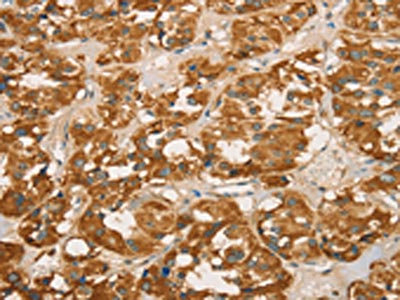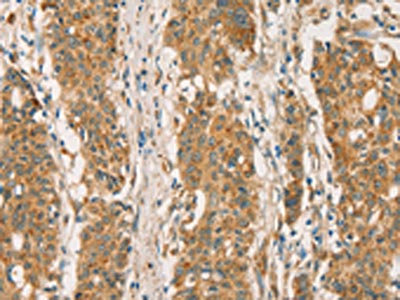RBBP8 Antibody
-
货号:CSB-PA089183
-
规格:¥1100
-
图片:
-
The image on the left is immunohistochemistry of paraffin-embedded Human thyroid cancer tissue using CSB-PA089183(RBBP8 Antibody) at dilution 1/65, on the right is treated with fusion protein. (Original magnification: ×200)
-
The image on the left is immunohistochemistry of paraffin-embedded Human gastric cancer tissue using CSB-PA089183(RBBP8 Antibody) at dilution 1/65, on the right is treated with fusion protein. (Original magnification: ×200)
-
-
其他:
产品详情
-
Uniprot No.:Q99708
-
基因名:RBBP8
-
别名:COM1 antibody; COM1_HUMAN antibody; CtBP interacting protein antibody; CtBP-interacting protein antibody; CtIP antibody; DNA endonuclease RBBP8 antibody; JWDS antibody; RB binding protein 8 endonuclease antibody; RBBP-8 antibody; RBBP8 antibody; Retinoblastoma-binding protein 8 antibody; Retinoblastoma-interacting protein and myosin-like antibody; Rim antibody; SAE2 antibody; SCKL2 antibody; Sporulation in the absence of SPO11 protein 2 homolog antibody
-
宿主:Rabbit
-
反应种属:Human,Mouse,Rat
-
免疫原:Fusion protein of Human RBBP8
-
免疫原种属:Homo sapiens (Human)
-
标记方式:Non-conjugated
-
抗体亚型:IgG
-
纯化方式:Antigen affinity purification
-
浓度:It differs from different batches. Please contact us to confirm it.
-
保存缓冲液:-20°C, pH7.4 PBS, 0.05% NaN3, 40% Glycerol
-
产品提供形式:Liquid
-
应用范围:ELISA,IHC
-
推荐稀释比:
Application Recommended Dilution ELISA 1:2000-1:10000 IHC 1:100-1:300 -
Protocols:
-
储存条件:Upon receipt, store at -20°C or -80°C. Avoid repeated freeze.
-
货期:Basically, we can dispatch the products out in 1-3 working days after receiving your orders. Delivery time maybe differs from different purchasing way or location, please kindly consult your local distributors for specific delivery time.
相关产品
靶点详情
-
功能:Endonuclease that cooperates with the MRE11-RAD50-NBN (MRN) complex in DNA-end resection, the first step of double-strand break (DSB) repair through the homologous recombination (HR) pathway. HR is restricted to S and G2 phases of the cell cycle and preferentially repairs DSBs resulting from replication fork collapse. Key determinant of DSB repair pathway choice, as it commits cells to HR by preventing classical non-homologous end-joining (NHEJ). Functions downstream of the MRN complex and ATM, promotes ATR activation and its recruitment to DSBs in the S/G2 phase facilitating the generation of ssDNA. Component of the BRCA1-RBBP8 complex that regulates CHEK1 activation and controls cell cycle G2/M checkpoints on DNA damage. During immunoglobulin heavy chain class-switch recombination, promotes microhomology-mediated alternative end joining (A-NHEJ) and plays an essential role in chromosomal translocations.
-
基因功能参考文献:
- Study identifies the KLHL15 as a new interaction partner of CtIP and show that KLHL15 promotes CtIP protein turnover via the ubiquitin-proteasome pathway. PMID: 27561354
- ATM-dependent phosphorylation of CtIP and the epistatic and coordinated actions of MRE11 and CtIP nuclease activities are required to limit the stable loading of Ku on single-ended DNA double-strand breaks. PMID: 27641979
- 53BP1/RIF1 has a role in limiting BRCA1/CtIP-mediated end resection to control double strand break repair pathway choice PMID: 27494840
- we reveal that reprogramming is associated with high levels of DNA end resection, a critical step in homologous recombination. Moreover, the resection factor CtIP is essential for cell reprogramming and establishment of iPSCs, probably to repair reprogramming-induced DNA damage. PMID: 28065643
- Data show that SUMO E3 ligase CBX4 sumoylates subpopulation of CtIP to regulate recruitment to breaks and resection. PMID: 28740167
- CtIP/Ctp1/Sae2/Com1 role in removal of DNA double strand breaks through DSB repair by homologous recombination is reviewed. PMID: 28623092
- Data delineates the regulatory mechanisms of GATA3 in DNA double-strand breaks repair and strongly suggests that it might act as a tumor suppressor by promoting CtIP expression and homologous recombination to stabilize genomes. PMID: 28481869
- The results illuminate the important role of Nbs1 and CtIP in determining the substrates and consequences of human Mre11/Rad50 nuclease activities on protein-DNA lesions. PMID: 27814491
- And-1 interacts with CtIP and that these interactions are required for DNA damage checkpoint maintenance, thereby linking DNA processing with prolonged cell cycle arrest to allow sufficient time for DNA repair. PMID: 27940552
- his shows that 53BP1 protects both close and distant DSEs from degradation and that the association of unprotection with distance between DSEs favors ECS capture. Reciprocally, silencing CtIP lessens ECS capture both in control and 53BP1-depleted cells. We propose that close ends are immediately/rapidly tethered and ligated, whereas distant ends first require synapsis of the distant DSEs prior to ligation PMID: 27798638
- Low level of CtIP expression is associated with breast cancer. PMID: 26713604
- Homozygous RBBP8 mutation is associated with microcephaly, intellectual disability, short stature and brachydactyly. PMID: 26333564
- USP4 cooperates with CtIP in DNA double-strand break end resection. PMID: 26387952
- CtIP is a DNA damage response protein at the intersection of DNA metabolism. (Review) PMID: 25957490
- Data show that ubiquitin E2 enzymes UBE2D1/2/3 and E3 ligase RNF138 accumulate at DNA-damage sites and act at early resection stages by promoting CtIP protein ubiquitylation and accrual. PMID: 26502057
- BRCA1 and CtIP contribute to DSB resection by recruiting Dna2 to damage sites, thus ensuring the robust DSB resection necessary for efficient homologous recombination. PMID: 25909997
- The CtIP 3'UTR is directly targeted by miR-19a and miR-19b. PMID: 25308476
- CtIP interacts with Cdh1 through a conserved KEN box, mutation of which impedes ubiquitylation and downregulation of CtIP both during G1 and after DNA damage in G2. PMID: 25349192
- Possible association of SOX-17 and RBBP8 with brain arteriovenous malformations, genes involved in cell cycle progression, deserves further investigation PMID: 25053769
- findings provide strong evidence that CtIP is continuously recruited to DSBs downstream of both the initiation and extension step of resection PMID: 25771978
- Data indicate that FANCD2 primes CtIP-dependent resection during HR after ICL induction but that CtIP helps prevent illegitimate recombination in FA cells. PMID: 24794434
- Study identified CtIP as a novel interaction partner of FANCD2. CtIP binds and stabilizes FANCD2 in a DNA damage- and FA core complex-independent manner, suggesting that FANCD2 monoubiquitination is dispensable for its interaction with CtIP. PMID: 24556218
- Plk3 binds to CtIP phosphorylated at S327 via its Polo box domains, which is necessary for robust damage-induced CtIP phosphorylation at S327 and subsequent CtIP phosphorylation at T847. PMID: 25267294
- These studies suggest that an end resection-independent CtIP function is important for processing double-strand break ends with secondary structures to promote homologous recombination. PMID: 24837675
- human CtIP is a 5' flap endonuclease and this activity is required in some contexts for the efficient function of CtIP. PMID: 24837676
- Low or no expression of RBBP8 correlates with high-grade breast cancer, poor prognosis and with nodal metastasis. PMID: 24403251
- our data demonstrate that CtIP is required for DNA damage-induced P21 induction PMID: 24196441
- Microsatellite instability dependent mutations were detected in CtIP in myeloid malignancies conferring hypersensitivity to PARP inhibitors. PMID: 23349304
- study identified a homozygous mutation in RBBP8, which co-segregates with microcephaly-associated intellectual disability syndrome in a Pakistani family; also identified a heterozygous deletion encompassing the NRXN1 in this family, which is present in 2 affected sibs with complex phenotype and the mother with mild phenotype PMID: 24440292
- BRCA1/CtIP-mediated processing of the second end of the break controls the annealing step that normally terminates synthesis-dependent strand annealing, thereby suppressing the error-prone long-tract gene conversion outcome. PMID: 23994874
- Taken together, these findings strongly suggest that an ATM-dependent CREB-miR-335-CtIP axis influences the selection of HRR for repair of certain DSB lesions PMID: 23696749
- These studies reveal one important mechanism to regulate cell-cycle-dependent activation of HR upon DNA damage by coupling CDK- and ATM-mediated phosphorylation of CtIP through modulating the interaction of CtIP with Nbs1 PMID: 23468639
- Data suggest that overexpression of LMO4 may disrupt some of the normal tumour suppressor activities of CtIP, thereby contributing to breast cancer progression. PMID: 23353824
- RIF1 accumulation at DSB sites is strongly antagonized by BRCA1 and its interacting partner CtIP PMID: 23333306
- CtIP binds to ATM protein proximal promoter, but after DNA damage Ctip is released. PMID: 22832221
- show that CHK1 was rapidly and robustly activated before detectable end resection PMID: 22733999
- The severe repair defects of CtIP dimerization mutants are likely due to the failure in localization to chromosomal DSBs upon DNA damage. PMID: 22544744
- The s show that, in human and mouse, Mre11 controls these events through a direct interaction with CDK2 that is required for CtIP phosphorylation and BRCA1 interaction in normally dividing cells. PMID: 22231403
- the SCKL2 mutation creates an alternative splicing site leading to both the normal and aberrant CtIP proteins coexisting in the cells of patients and carriers PMID: 21998596
- Studies indicate that codon-based models of gene evolution yielded statistical support for the recurrent positive selection of five NHEJ genes during primate evolution: XRCC4, NBS1, Artemis, POLlambda, and CtIP. PMID: 20975951
- This study identifies new functions of CtIP and EXO1 in DNA end resection and provides new information on the regulation of DNA double-strand breaks repair pathways, which is a key factor in the maintenance of genome integrity. PMID: 21052091
- BCR-ABL promotes mutagenic DSB repair with the DSB end-processing protein CtIP acting as the key mediator downstream of BCR-ABL PMID: 20974687
- identified double-strand break(DSB) resection protein CtIP as a SIRT6 interaction partner; showed SIRT6-dependent CtIP deacetylation promotes resection;CtIP identified as key substrate by which SIRT6 facilitates DSB processing and homologous recombination PMID: 20829486
- Data found that HMGA2, along with a dozen of other genes, was co-repressed by ZBRK1, BRCA1, and CtIP. PMID: 20007691
- CtIP facilitates the transition from DSB sensing to processing, by binding to the DNA at double-strand breaks (DSBs) after DSB sensing and ATM activation and then promoting DNA resection, leading to checkpoint activation and homologous recombination. PMID: 20064462
- These findings reveal a novel complex between BRCA1, LMO4, and CtIP and indicate a role for LMO4 as a repressor of BRCA1 activity in breast tissue. PMID: 11751867
- a corepressor complex containing CtIP/CtBP facilitates RBP-Jkappa/SHARP-mediated repression of Notch target genes PMID: 16287852
- CTIP activates its own and cyclin D promoters via the E2F/RB pathway during G1/S progression. PMID: 16581787
- Since CtIP plays important roles in cell cycle checkpoint control and it has been implicated in tumorigenesis, our data suggest that TRB3 may be involved in these biological processes through interacting with CtIP. PMID: 17112672
- Data show that CtIP expression is induced by AdE1A during viral infection and that reduction of CtIP expression with RNA interference can retard virus replication. PMID: 17546052
显示更多
收起更多
-
相关疾病:Seckel syndrome 2 (SCKL2); Jawad syndrome (JWDS)
-
亚细胞定位:Nucleus. Chromosome.
-
蛋白家族:COM1/SAE2/CtIP family
-
组织特异性:Expressed in ER-positive breast cancer lines, but tends to be down-regulated ER-negative cells (at protein level).
-
数据库链接:
HGNC: 9891
OMIM: 251255
KEGG: hsa:5932
STRING: 9606.ENSP00000323050
UniGene: Hs.546282
Most popular with customers
-
-
YWHAB Recombinant Monoclonal Antibody
Applications: ELISA, WB, IF, FC
Species Reactivity: Human, Mouse, Rat
-
Phospho-YAP1 (S127) Recombinant Monoclonal Antibody
Applications: ELISA, WB, IHC
Species Reactivity: Human
-
-
-
-
-






















